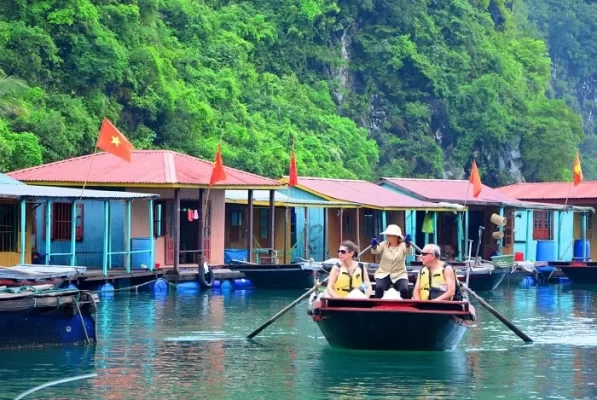
Let’s find out the best time to visit Halong Bay!
Discover the best times to visit Halong Bay with Ula Travel‘s comprehensive guide on Halong Bay weather. Explore seasonal weather patterns, including spring’s mild temperatures, summer’s heat and rainfall, autumn’s cool and dry conditions, and winter’s crisp air. Get tips on what to wear, what to do each season, and how to plan your trip based on the latest weather forecasts. It’s perfect for international tourists seeking the ideal time to experience Halong Bay’s stunning landscapes and attractions.
I. Overview of Halong Bay
1. Location of Halong Bay
Halong Bay is situated in northeastern Vietnam, in Quang Ninh Province. This picturesque bay extends over 1,553 square kilometers and is part of the Gulf of Tonkin, bordered by the South China Sea. It is approximately 170 kilometers east of Hanoi, the capital city of Vietnam.
2. A UNESCO World Heritage Site

Halong Bay was twice recognized as a World Heritage Site by UNESCO.
Halong Bay was designated a UNESCO World Heritage Site in 1994 due to its outstanding natural beauty and significant geological formations. It was later recognized as a World Heritage Site for a second time in 2000, specifically for its exceptional geological and geomorphological values. This prestigious status highlights its global significance and the need for its conservation.
3. Natural Highlights
- Stunning Karst Landscapes: Halong Bay is renowned for its spectacular karst landscape, characterized by over 1,600 limestone islands and islets that rise dramatically from the emerald waters. These islands feature a variety of formations, including steep cliffs, sea stacks, and caves, creating a mesmerizing seascape.
- Unique Caves and Grottos: Among the bay’s most famous natural attractions are its stunning caves and grottos. Notable examples include Sung Sot Cave (Surprise Cave), which boasts impressive stalactites and stalagmites, and Thien Cung Cave (Heavenly Palace Cave), known for its intricate formations and vast chambers.
- Rich Marine Biodiversity: The bay is home to a diverse range of marine life, including various species of fish, mollusks, and coral reefs. The unique ecosystem supports both aquatic and avian species, making it a prime location for biodiversity and conservation efforts.
- Traditional Fishing Villages: Halong Bay is also known for its traditional fishing communities that live in floating villages. These villages offer a glimpse into the local culture and way of life, showcasing traditional fishing practices and maritime skills that have been passed down through generations.
- Cultural Significance: The bay has been a crucial site for maritime trade and cultural exchange for centuries. Its historical significance is reflected in the numerous legends and folklore associated with the area, adding a layer of cultural depth to its natural splendor.
- Tourist Attractions and Activities: Visitors to Halong Bay can engage in a variety of activities, such as cruising the bay on traditional wooden junks, kayaking through its tranquil waters, hiking to panoramic viewpoints, and exploring the vibrant markets and cultural sites of the nearby towns.
II. Halong Bay Weather in 4 seasons
1. Spring (March–May)

Spring in Ha Long Bay has a mild and pleasant climate.
Spring in Halong Bay, spanning from March to May, is characterized by pleasantly mild temperatures and gradually increasing warmth. During this season, the average temperature ranges from 18°C to 25°C (64°F to 77°F).
The weather is relatively dry compared to the summer months, with occasional light showers that contribute to the lush greenery of the region. The humidity levels start to rise but remain comfortable, making outdoor activities enjoyable. Spring often brings clear skies and ample sunshine, with longer daylight hours, enhancing the beauty of the bay.
Highlights:
- Scenic Beauty: Spring is a fantastic time to visit Halong Bay due to the stunning scenery. The landscape comes alive with vibrant green hues and blooming flowers, creating picturesque views perfect for photography.
- Pleasant Weather: The mild temperatures and lower humidity make it an ideal time for outdoor activities such as hiking, boat tours, and exploring the bay’s islands and caves without the discomfort of intense heat.
- Outdoor Activities: The comfortable weather allows for a wide range of activities, including kayaking, swimming, and hiking. The gentle breeze and pleasant temperatures make boat tours especially enjoyable, as visitors can comfortably take in the breathtaking views of the limestone karsts and emerald waters.
Start your journey with: Best Hanoi to Halong Bay Tour with 2 Days 1 Night
2. Summer (June–August)

Summer in Halong Bay has quite high temperatures and can be stormy.
During the summer months, Halong Bay experiences high temperatures and elevated humidity levels. Average daytime temperatures range from 28°C to 35°C (82°F to 95°F). The high humidity often makes it feel even warmer.
This period is also characterized by frequent short, heavy rain showers and occasional thunderstorms, as well as the potential for tropical storms and typhoons. It’s not uncommon to encounter sudden downpours, so having rain gear handy is essential.
Travel Benefits:
- Water-based activities: The warm weather and relatively calm seas create ideal conditions for swimming, kayaking, and snorkeling. The vibrant marine life and clear waters of Halong Bay make it a perfect destination for underwater exploration. Additionally, summer offers ample opportunities for relaxing beach vacations, with many visitors choosing to unwind on the picturesque beaches and enjoy the scenic views of the bay.
- Outdoor activities include hiking and boat tours. The long daylight hours provide plenty of time to explore the numerous islands, caves, and scenic spots around Halong Bay.
You might be like: Best Ha Long Bay Cruise Tour
3. Autumn (September – November)

Autumn is the ideal time to visit Halong Bay.
During the autumn months, Halong Bay experiences a noticeable drop in temperature, making the weather cooler and more comfortable. Daytime temperatures generally range from 22°C to 28°C (72°F to 82°F), while nighttime temperatures can dip to around 18°C to 22°C (64°F to 72°F).
The humidity levels decrease significantly compared to the summer months, creating a dry and pleasant atmosphere. Rainfall becomes less frequent, with occasional light showers that usually don’t last long, allowing for uninterrupted exploration and sightseeing.
Travel Benefits:
- Autumn is one of the most favorable times to visit Halong Bay due to its pleasant weather conditions. The cooler temperatures and lower humidity make outdoor activities more enjoyable, whether you’re cruising through the bay, hiking, or exploring the caves and islands.
- The clear skies and reduced rainfall also enhance visibility, offering stunning panoramic views of the bay’s emerald waters and towering limestone karsts. This is an ideal period for photography enthusiasts who want to capture the bay’s picturesque landscapes in optimal light conditions.
More details: Ninh Binh to Halong Bay – Heritage Road Journey 4D3N
4. Winter (December–February)

Experiencing Halong Bay in winter is also an interesting thing.
During the winter months from December to February, Halong Bay experiences a noticeable drop in temperatures, ranging from 15°C to 20°C (59°F to 68°F). The weather is generally cool and crisp, with lower humidity compared to the warmer seasons.
Rainfall is infrequent, and the sky tends to be clearer, offering stunning views of the bay’s majestic landscape. While the temperatures can be quite chilly, particularly in the mornings and evenings, the overall climate remains pleasant and manageable.
Travel Benefits:
- Winter is an excellent time to visit Halong Bay for several reasons. Firstly, the cooler temperatures create a refreshing environment for exploring the natural beauty of the bay. The lower humidity and reduced rainfall make outdoor activities more enjoyable.
- Additionally, the winter season sees fewer tourists, allowing for a more serene and intimate experience of Halong Bay’s iconic sites. You can enjoy the stunning scenery and popular attractions without the usual crowds, providing a more relaxed and personal travel experience.
Click here: Northern Vietnam Itinerary
III. Activities in Halong Bay by Season
1. Spring (March–May)

Spring in Halong Bay is suitable for outdoor activities
- Explore the Bay: Spring is an excellent time to visit Halong Bay due to the mild weather and blooming landscapes. Take a leisurely boat tour through the bay to admire the stunning limestone karsts and emerald waters. The calm seas and pleasant temperatures create the perfect conditions for a relaxing cruise.
- Kayaking: The spring offers ideal conditions for kayaking. The waters are usually calm, and the temperatures are comfortable. Kayaking allows you to get up close to the bay’s natural beauty, exploring hidden caves and secluded lagoons that larger boats might miss.
- Visit Caves: Halong Bay is renowned for its impressive caves. Spring’s moderate weather makes it an ideal time to visit these natural wonders. Popular caves such as Sung Sot Cave (Surprise Cave) and Thien Cung Cave (Heavenly Palace Cave) offer breathtaking views of stalactites and stalagmites.
Read more: Kayaking in Halong Bay
2. Summer (June–August)

Tourists immerse themselves in the clear blue water in the summer at Halong Bay.
- Beach Swimming: Summer brings hot and humid weather to Halong Bay, making it perfect for a refreshing swim. The bay’s beaches, such as Bai Chay and Ti Top Island, are ideal spots to relax and enjoy the sun. The warm water temperatures are inviting for both swimming and sunbathing.
- Boat Rides: The summer season is perfect for boat rides and island-hopping. Take advantage of the long daylight hours and enjoy a boat trip to explore the bay’s various islands and beaches. Activities like fishing and swimming can be easily incorporated into your boat tour.
- Water Sports: With warm temperatures and good water conditions, summer is the best time to engage in water sports. Try out activities like jet skiing, paddleboarding, and snorkeling. These activities offer a fun way to experience the bay’s beautiful waters and vibrant marine life.
3. Autumn (September–November)

Admire the beauty of Halong Bay from the helicopter.
- Scenic Sightseeing: Autumn is one of the best times to visit Halong Bay for its mild weather and clear skies. Enjoy breathtaking views of the bay’s landscapes as the foliage starts to change colors. This is an ideal time for scenic photography, capturing the bay’s beauty against the backdrop of crisp autumn air.
- Island Hopping: Explore the bay’s numerous islands during the autumn, when the weather is cooler and more comfortable. Visit islands such as Cat Ba and Co To, each offering unique attractions and natural beauty. Autumn’s pleasant temperatures make for enjoyable outdoor excursions and leisurely exploration.
- Photography: Autumn’s clear skies and stunning natural scenery provide fantastic opportunities for photography enthusiasts. Capture the bay’s dramatic limestone formations, tranquil waters, and vibrant autumn colors. Early morning and late afternoon light often create magical photographic conditions.
4. Winter (December–February)

Visiting the fishing village is an interesting experience.
- Visit Fishing Villages: Winter brings cooler temperatures to Halong Bay, making it a good time to visit local fishing villages. Explore traditional floating villages, such as Vung Vieng and Cua Van, to experience the local way of life. Winter’s calm seas and cool weather make these visits more comfortable and enjoyable.
- Enjoy the Tranquil Atmosphere: Winter’s quieter tourist season offers a more peaceful experience. The reduced crowds and cooler weather create a serene atmosphere, perfect for relaxation and contemplation. Enjoy a peaceful boat ride or a leisurely walk along the waterfront to soak in the tranquil ambiance of the bay.
- Cultural Experiences: Take advantage of the quieter winter season to delve into local culture. Visit local markets and try traditional Vietnamese cuisine. Participate in cultural activities and learn more about the region’s history and customs. Winter’s cooler temperatures make exploring cultural sites and local attractions more pleasant.
IV. Must-Visit Attractions in Halong Bay
1. Sung Sot Cave (Surprise Cave)

Sung Sot Cave
Sung Sot Cave, also known as the “Surprise Cave,” stands as one of Vietnam’s most awe-inspiring natural wonders. The journey into Sung Sot Cave begins with a series of stairs leading to a grand entrance, where visitors are immediately greeted by an expansive, cavernous space adorned with intricate stalactites and stalagmites.
As you wander through the cave’s two main sections, you’ll be captivated by the extraordinary geological formations and the ethereal atmosphere that make Sung Sot Cave a must-visit destination.
2. Ti Top Island

Ti Top Island
Ti Top Island, a picturesque retreat nestled in the heart of Halong Bay, is renowned for its stunning natural beauty and tranquil atmosphere. The island features a pristine sandy beach, ideal for swimming and sunbathing, and a scenic viewpoint accessible via a short hike, which provides breathtaking panoramic views of Halong Bay’s emerald waters and limestone karsts.
Whether you’re looking to unwind on its serene shores or explore its natural splendor, Ti Top Island promises an unforgettable experience in one of Vietnam’s most enchanting destinations.
3. Cat Ba Island

Cat Ba Island
Cat Ba Island is a captivating destination renowned for its stunning natural beauty and tranquil atmosphere. As the largest island in the Cat Ba Archipelago, it offers a unique blend of lush landscapes, pristine beaches, and dramatic limestone cliffs.
Visitors can explore the charming fishing villages, relax on the unspoiled beaches, or take a boat tour to admire the stunning seascape of Ha Long Bay. With its blend of adventure, relaxation, and cultural immersion, Cat Ba Island promises an unforgettable experience for every traveler.
Read more: Top 4 Most Beautiful Halong Bay Islands
4. Cua Van Floating Village

Cua Van Floating Village
Cua Van Floating Village offer a captivating glimpse into traditional Vietnamese life on the water. These picturesque floating villages are home to local fishermen who have lived in harmony with the bay’s natural beauty for generations. The villages feature charming wooden houses, colorful boats, and a serene atmosphere that transports visitors to a simpler, slower-paced way of life.
Exploring Cua Van provides a unique opportunity to experience the vibrant culture and daily routines of the villagers, including their fishing practices, traditional crafts, and communal activities. A visit to Cua Van Floating Village promises an unforgettable adventure and a deeper appreciation for the rich heritage and natural wonders of Halong Bay.
Do not miss: Things to Do in Halong Bay
5. Ba Hang Fishing Village

Ba Hang Fishing Village
Ba Hang Fishing Village offers a serene retreat from the bustling city life. This charming village is renowned for its traditional fishing practices, which have been passed down through generations.
Visitors to Ba Hang can experience an authentic glimpse into the daily lives of the local fishermen, who live in floating houses and rely on the bountiful waters of Halong Bay for their livelihood. The warm hospitality of the villagers and the peaceful atmosphere make Ba Hang a perfect destination for those seeking both cultural enrichment and natural beauty.
6. Dau Go Cave (Wooden Stakes Cave)

Dau Go Cave
Dau Go Cave (Wooden Stake Cave) is a captivating natural wonder renowned for its stunning rock formations and rich history. This awe-inspiring cave is celebrated for its impressive stalactites and stalagmites, which have been sculpted by nature over millennia.
Dau Go Cave earned its name from the wooden stakes used by Vietnamese warriors to repel Mongol invaders in the 13th century. A visit to Dau Go Cave offers an unforgettable journey into the heart of Halong Bay’s natural beauty and historical legacy.
In conclusion, understanding Halong Bay weather is crucial for planning an unforgettable trip to this stunning UNESCO World Heritage Site. Each season offers its own unique charm and opportunities, from the mild and pleasant spring to the warm and lively summer, the crisp and comfortable autumn, and the cool and serene winter. By being aware of the seasonal weather patterns, you can choose the best time to visit Halong Bay. Be sure to check reliable weather forecasts before your trip and plan accordingly to ensure a smooth and enjoyable visit.
See more: Halong Bay Travel Tips




























